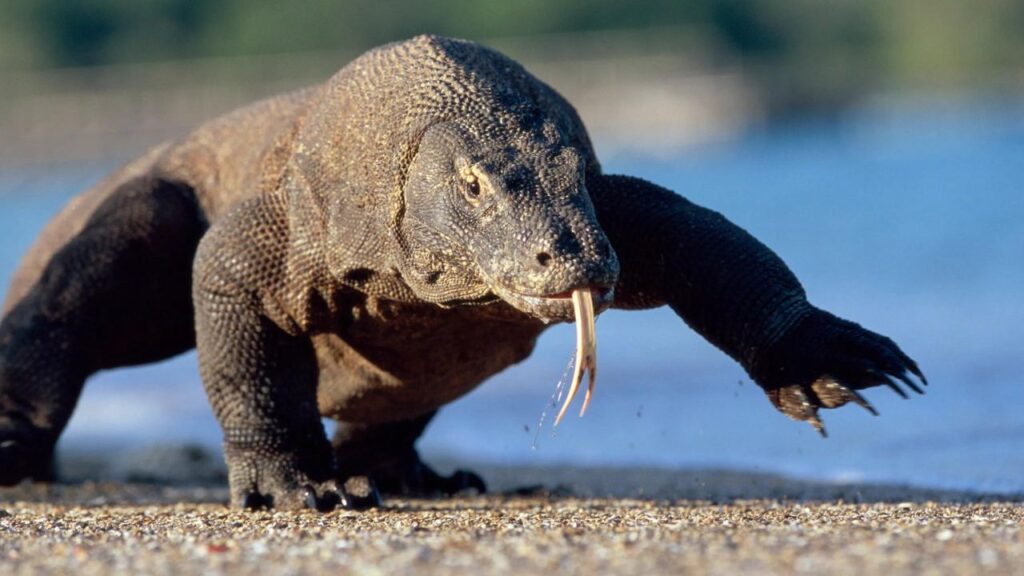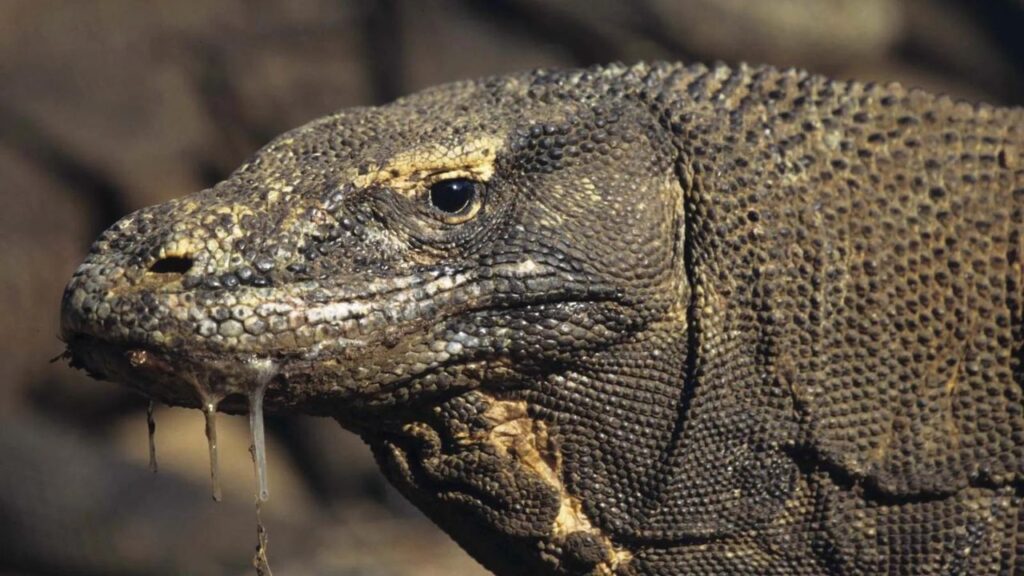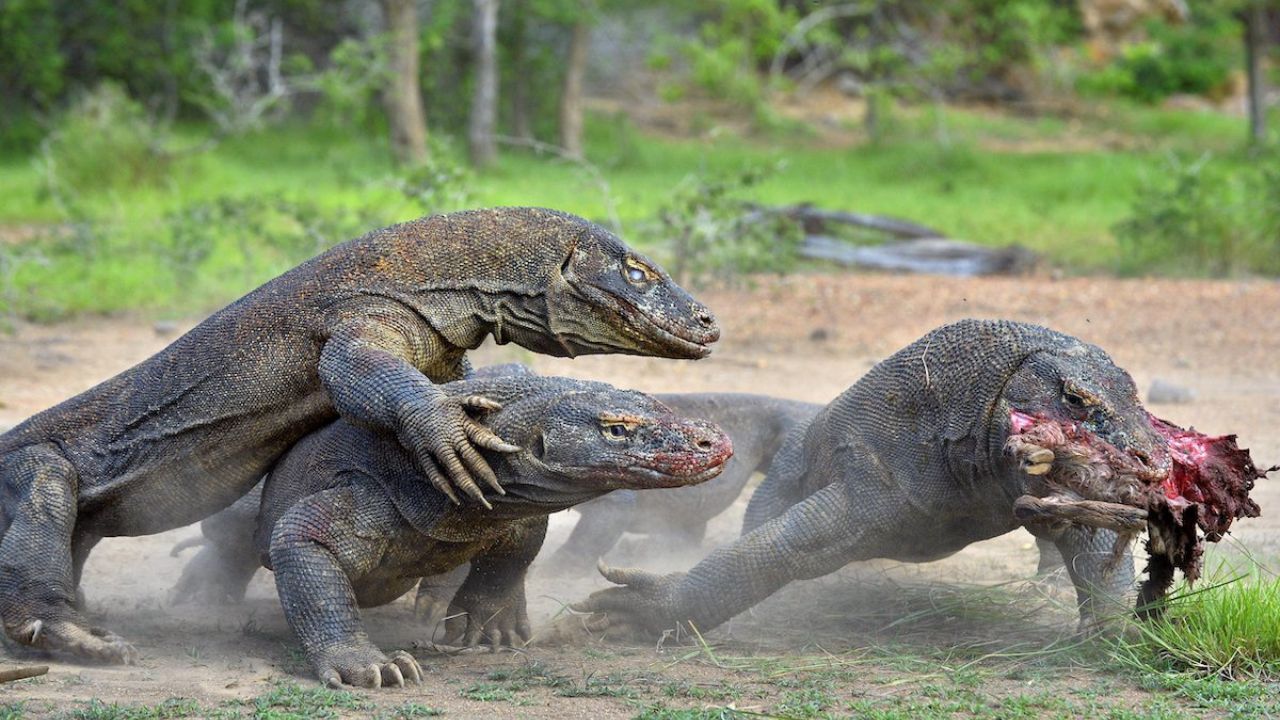Do Komodo Dragons Attack Humans? Yes, Komodo dragons can and do attack humans. These attacks are rare but have resulted in fatalities both in the wild and in captivity.
Komodo dragons, the largest lizards on the planet, have long fascinated and terrified people.
Native to Indonesia, these formidable reptiles are known for their incredible strength, sharp teeth, and venomous bite.
This article will provide an in-depth look at Komodo dragon attacks on humans, exploring their behavior, reasons for attacks, and how to stay safe in their presence.
Contents
- 1 Who Is the Komodo Dragon?
- 2 Do Komodo Dragons Attack Humans?
- 3 How to Stay Safe Around Komodo Dragons
- 4 Komodo Dragons in Captivity
- 5 Frequently Asked Questions (FAQs)
- 5.1 Are Komodo Dragon Attacks Common?
- 5.2 Why Are Komodo Dragons Dangerous?
- 5.3 Can You Survive a Komodo Dragon Bite?
- 5.4 Where Can You Find Komodo Dragons?
- 5.5 How Fast Can Komodo Dragons Run?
- 5.6 What Should You Do If You Encounter a Komodo Dragon?
- 5.7 What Do Komodo Dragons Eat?
- 5.8 How Do Komodo Dragons Hunt?
- 5.9 Are Komodo Dragons Endangered?
- 5.10 How Can You Help Protect Komodo Dragons?
- 6 Conclusion: Do Komodo Dragons Attack Humans?
Who Is the Komodo Dragon?
Introduction to Komodo Dragons
Komodo dragons (Varanus komodoensis) inhabit the Indonesian islands of Komodo, Rinca, Flores, and Gili Motang.
They are the apex predators of their ecosystem, growing up to 10 feet in length and weighing over 150 pounds.
Known for their fearsome appearance and predatory capabilities, these reptiles are a subject of both fascination and fear.
Physical Characteristics
Komodo dragons have rough, durable skin that provides protection in their harsh environment.
They possess powerful limbs, sharp claws, and serrated teeth, ideal for hunting and tearing flesh.
One of their most dangerous attributes is their venom, which prevents blood clotting and induces shock in their prey.
Habitat and Distribution
Komodo dragons are found in a limited range of islands in Indonesia. Their primary habitats include dry, open grasslands, savannas, and tropical forests at low elevations.
These environments provide ample prey and suitable conditions for their survival. Conservation efforts are crucial to protect these habitats from human encroachment and environmental changes.
Diet and Hunting Behavior
Komodo dragons are carnivorous and have a varied diet that includes deer, wild boar, water buffalo, and even smaller dragons.
They are opportunistic feeders and will consume carrion when available. Using their keen sense of smell, they can detect dead or dying animals from miles away.
Their hunting strategy involves stealth, patience, and a powerful ambush, relying on their strong bite to incapacitate their prey.

Do Komodo Dragons Attack Humans?
Documented Attacks
While Komodo dragon attacks on humans are rare, they do happen and can be deadly. Here are some notable cases:
- Muhamad Anwar (2009): This 31-year-old fisherman was fatally attacked by two Komodo dragons after falling from a tree on Komodo Island. Despite the efforts of neighbors to save him, he succumbed to his injuries.
- Scuba Divers (2008): A group of scuba divers was swept to Rinca Island, where they were attacked by Komodo dragons. They endured a harrowing ordeal before being rescued.
- Boy in the Scrubland (Year Unspecified): A boy playing near his village was attacked by a Komodo dragon and died from massive bleeding.
Reasons for Attacks
Komodo dragons attack humans for two primary reasons: defense and predation. [Do Komodo Dragons Attack Humans?]
Defensive Attacks
Komodo dragons may attack if they feel threatened or cornered. These reptiles are known to defend their territory aggressively, and any perceived threat can provoke an attack.
Predatory Attacks
Komodo dragons are opportunistic predators. Humans, especially those who appear vulnerable or isolated, can be seen as potential prey.
The dragons’ powerful bite and venom make them capable of taking down large animals, including humans. [Do Komodo Dragons Attack Humans?]
Venom and Bite
The venom of a Komodo dragon prevents blood from clotting, leading to rapid blood loss and shock.
Their bite force is around 1,000 PSI, and their sharp teeth can cause severe wounds.
The combination of venom and bacteria in their mouths makes their bites particularly dangerous.
Frequency of Attacks
Komodo dragon attacks on humans are not common but do occur.
According to data from Komodo National Park, there were 24 reported attacks on humans between 1974 and 2012, five of which were fatal.
Most victims are local villagers living near the dragons’ habitat. [Do Komodo Dragons Attack Humans?]

How to Stay Safe Around Komodo Dragons
Safety Precautions
When visiting areas inhabited by Komodo dragons, it is essential to take safety precautions:
Do Not Go Alone
Komodo dragons typically hunt isolated targets. Always travel in groups and consider hiring a local guide familiar with their behavior.
Stay on the Path
Stick to designated trails and avoid venturing into unknown areas. Komodo dragons are adept at camouflage and can ambush unsuspecting visitors.
Keep Your Distance
Maintain a safe distance from these reptiles. If you encounter a Komodo dragon, avoid making sudden movements, as this can provoke an attack.
Run in a Zig-Zag Pattern
If a Komodo dragon charges at you, running in a zig-zag pattern can help you evade it. These lizards have low stamina and struggle with sharp turns.
Emergency Response
If you are bitten by a Komodo dragon, seek immediate medical attention. [Do Komodo Dragons Attack Humans?]
The venom can cause rapid blood loss and shock, so timely intervention is critical.
Keeping the wound clean and applying pressure to stop bleeding can help manage the situation until help arrives. [Do Komodo Dragons Attack Humans?]
Long-Term Safety Measures
To ensure long-term safety, local authorities and conservation organizations must work together to manage human-dragon interactions.
This includes educating locals and tourists about the risks, improving medical facilities on the islands, and implementing strict regulations on human activities in Komodo dragon habitats.

Komodo Dragons in Captivity
Behavior in Zoos
Komodo dragons are kept in zoos and wildlife parks worldwide, where they serve as ambassadors for their species.
In captivity, these lizards are provided with environments that mimic their natural habitats, including temperature regulation and a diet similar to what they would find in the wild.
Safety in Captivity
Even in captivity, Komodo dragons pose a danger to humans. Zookeepers and handlers follow strict safety protocols when interacting with these reptiles.
Enclosures are designed to prevent escape and minimize the risk of injury to both the dragons and the people caring for them.
Conservation Efforts
Zoos play a critical role in the conservation of Komodo dragons. They participate in breeding programs to ensure genetic diversity and collaborate with Indonesian authorities on conservation initiatives.
Public education programs in zoos raise awareness about the threats facing Komodo dragons and the importance of protecting their natural habitats.
See Also: Do Wolves Attack Humans? The Real Risk!
Frequently Asked Questions (FAQs)
Are Komodo Dragon Attacks Common?
No, attacks on humans are rare but can be fatal. Most attacks occur in the wild, often involving locals or tourists in the dragons’ natural habitat.
Why Are Komodo Dragons Dangerous?
Komodo dragons are dangerous due to their powerful bite, venom, and aggressive nature when threatened. Their venom prevents blood clotting, causing victims to bleed profusely.
Can You Survive a Komodo Dragon Bite?
Survival depends on the severity of the bite and the speed of medical intervention. Immediate treatment is crucial to manage blood loss and prevent infection.
Where Can You Find Komodo Dragons?
Komodo dragons are native to Indonesia, specifically the islands of Komodo, Rinca, Flores, and Gili Motang. They can also be found in some zoos worldwide.
How Fast Can Komodo Dragons Run?
Komodo dragons can run up to 12 miles per hour in short bursts. However, they have low stamina and cannot maintain this speed for long distances.
What Should You Do If You Encounter a Komodo Dragon?
Stay calm, avoid sudden movements, and slowly back away. If the dragon charges, run in a zig-zag pattern to evade it. Seek immediate medical attention if bitten.
What Do Komodo Dragons Eat?
Komodo dragons are carnivorous and eat a variety of prey, including deer, wild boar, water buffalo, and smaller dragons. They are also scavengers and will eat carrion when available.
How Do Komodo Dragons Hunt?
Komodo dragons use a combination of stealth, patience, and powerful ambushes to hunt their prey. They rely on their strong bite and venom to incapacitate their victims.
Are Komodo Dragons Endangered?
Yes, Komodo dragons are classified as endangered due to habitat loss, human encroachment, and climate change. Conservation efforts are essential to protect these reptiles and their habitats.
How Can You Help Protect Komodo Dragons?
Supporting conservation organizations, respecting wildlife regulations, and raising awareness about the threats facing Komodo dragons can help protect these magnificent creatures.
Conclusion: Do Komodo Dragons Attack Humans?
Komodo dragons are fascinating yet dangerous creatures. Understanding their behavior and taking appropriate safety measures can help prevent attacks.
When visiting areas where these lizards live, always be vigilant, travel in groups, and respect their natural habitat.
By staying informed and cautious, we can appreciate the beauty of Komodo dragons from a safe distance, ensuring both our safety and the preservation of these incredible animals.
By being aware of the risks and knowing how to respond, we can coexist with these magnificent reptiles while minimizing the danger they pose.

Hello, I am Rosa Ellis, a mother of two and a wildlife blogger. I grew up in New York City, but I love exploring forests. I’ve traveled to places like Yellowstone National Park and the Amazon Rainforest to see animals up close. I know a lot about animal behavior and which animals can be dangerous to humans. Thanks for visiting my blog!

